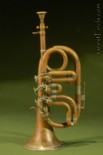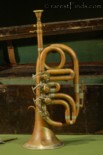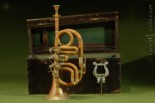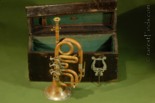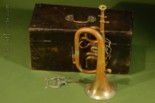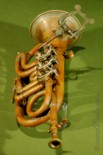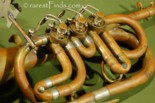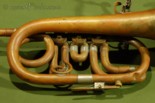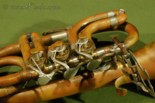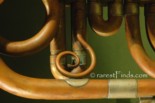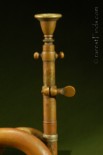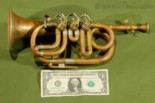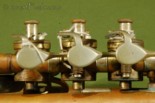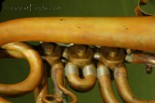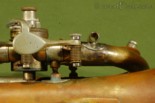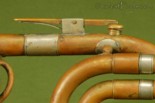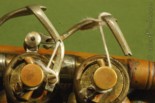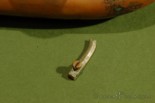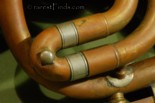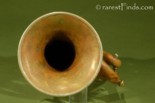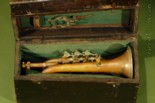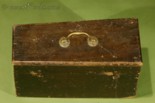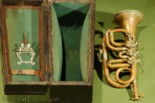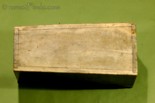Rare Civil War Pocket Cornet in Eb, with Top Action Rotary Valves, all complete with Mouthpiece, original Lyre Sheet Music Holder, and original carrying Case.
This rare pocket cornet is very cute, measuring only 12-3/4 inches in length! See picture #12 showing the instrument with a $1 bill for comparison. The bell of the instrument measures only 4-3/16 inches in diameter.
At least one cornet was part of any civil war area brass band, leading soldiers into battle. Most of these instruments were destroyed in battle, hence, they are difficult to find in any condition. The cornet in E flat is, as its counterpart pitched in B flat, a transposing instrument pitched a quarter higher.
This Cornet features a tuning mechanism as shown in picture #11. The tuning mechanism works as intended. The only thing that is missing is the little knob you grab to remove the slide on the first valve, see picture #7. Picture #19 shows one of these knobs on the slide of the third valve.
This beautiful instrument has one of the ornamental scrolled bridges typicla for instruments of that period, see picture #10.
Condition:
This rare instrument is in "as found" condition. There are no holes that I can see, the lever of the first valve is broken where the string is attached to activate the valve, see picture #18. However, the broken-off part was, and still is, in the original wooden case when the instrument was found, see picture #19. All three valves are working and turn freely. I did not attempt to remove the slides. The tuning mechanism comes apart easily. The mouthpiece seems to be original to the instrument and was inside the case when the instrument was found. There seems to be a little brass knob missing on the first valve tubing; the little knob to grab when removing the slide of the first valve. There are no patches to repair holes and very few dents. The bell-garland is perfect and has no cracks or other issues.
This instrument seems to be complete, even the lyre shaped sheet music holder is still present.
History:
The following introduction to the E flat Soprano Cornet was excerpted from a brief article by Bram Gay in Sounding Brass, Issue 6, 1977. It seems to provide a non-controversial starting point.
The soprano is essentially a saxhorn in high E flat (Berlioz would recognize it instantly) which means, approaching it from another angle, that it is a kind of conical bore E Flat Trumpet. Its function in the band is the obvious one, the supply of the octave above the B flat instrument (Cornet). In this it is, as one would immediately assume, less successful than a piccolo B flat cornet would be. But the E flat instrument has a capacity for the lyrical which is hard to sustain in smaller instruments and in the hands of a rare small number of fine artists it can make a contribution, through its flexibility and highly individual color (in a medium where a fresh color is a life-saver) hardly to be achieved by any piccolo we have so far seen. It is of very little use below the stave, because its tone there is thin and its intonation usually questionable. These days composers write for it as high as C. We have seen higher notes and heard them too, though not as often.
Fine soprano cornet players are indeed few. Charlie Cook of Fodens I always consider to have been, with Dennis Brain, one of the two finest brass players of whom I have had personal experience (Bram Gray).
The Instrument (E flat cornet) seems to require a certain quirky, fatalistic personality in the player. A very famous soprano cornet virtuoso once said that to play the soprano at all you have to be a bitty crazy. To play it well, really nuts. And to play it as well as I do, mad as a hatter. The instruments are in some cases much better now than when that remark was made, and a large number of quite sane people play it decently today.
There are not a lot of resources on the historical development of this instrument. What history that this author was able to find was cloudy to say the least. In spite of its history, the utilization of the E flat Cornet is almost universal in the Brass Band world.
Basically, the E flat cornet is pitched a fourth higher than its B flat counterpart. It provides an airy, flute-like obbligato above the solo cornets in the brass band. This is the sound quality of a brass band that brings about the comment, What is that? Striking to the ear as well are the high counter melodies made possible by this instrument. The top of the score in brass band is the E flat Soprano Cornet. The uninitiated ear is quite surprised at this nearly whistling high soprano voice in the texture.
The clarino register would seem easier to play on this instrument, although it is not the primary feature of the E flat cornet in the brass band.
The players I am familiar with did not seem to think it was anything unusual to play the E flat soprano Cornet. Most of them stayed with this instrument once they had switched to it from the B flat cornet.
The instrument itself is not tiny, as many suspect. I was quite shocked when I realized that the gross dimensions of the Eb Soprano differ very little from the standard Shepherds Crook Bb Cornet.
The visual comparison was done on Boosey & Hawkes instruments. Many models of the E flat cornet are distinguished by the appearance of a second deep crook forward.
The tiny piccolo instruments that are seen sometimes in modern recitals (or even in some brass bands!) are frequently not E flat Soprano Cornets. These are frequently E flat trumpets, distinguished by a longer lead pipe and tiny body. Also, a small, short piccolo B flat cornet (Pocket trumpet)has been marketed as a novelty instrument in the last few years by more than one company.
It should also be remembered that European Brass Bands still sometimes deploy E flat Soprano Flugelhorns (It. Pikolo) to play parts scored for E flat Soprano Cornet. If you see a small cornet with rotary valves, in a European Band, it is a Soprano (E flat) flugelhorn until proven otherwise.
There are some beautiful solo works for E flat Soprano Cornet. Many are unpublished. If you ever see Demelza in print, snap it up. I heard this beautiful piece in New Zealand and was quite surprised at how the instrument handled this beautiful lyrical solo. To my knowledge, this piece remains in manuscript form unpublished.
Another important use of the Eb cornet in scoring is to combine it with various other instruments or groups of instruments for colorshadings.
It can be utilized as back up support for solo cornet obbligato, as well as for the high flute-like whistling countermelody in both marches and lyrical pieces. None of these effects in its high register should be overdone.
Kevin Thompson, has a particularly good scoring insight for this instrument: Writing for a young or inexperienced E flat soprano player demands considerable thought and attention. The E flat soprano player should not be used merely to support the solo B flat cornets in their high register. It is again unwise to score E flat cornet soaring head and shoulders above the rest. Unless the player is exceptionally expressive, experienced and consistent, this not a good idea. A high Eb Cornet may be exhilarating to hear, and may well claim attention. It is safer and wiser to regard the instrument as having a similar quality of expression to that of the flute rather than that of the piccolo. This would hold true especially when writing for the less experienced E flat cornet players in a school or beginners brass band. The Eb cornet is
light in tonal quality as opposed to shrill. It may therefore be used in transparently scored passages, perhaps where the full-bodied rounded tone of a Bb cornet would be out of character. Played well, Eb cornet has a wispy flute-like quality in contrast to the more rounded tone of the Bb cornets.
A brief interlude to give credit where it is due.
Gray, Bram, Cornet High and Dry, Sounding Brass , Issue 6, 1977.
Thompson, Kevin. Wind bands and Brass Bands in School and Music Center. Cambridge University Press. New York, Cambridge, London, Sydney, Melbourne. 1984.
Inventory Number 00999;
Price: Sold!
